Open Chords on Guitar
Easy Chord Shapes With Open Strings
Open chords are chords played on the guitar that don't have all the strings fretted .
One of the biggest obstacles when first playing is how difficult the strings are to push down.
Especially if you are playing a steel stringed acoustic with not the greatest action, it can be hard to play chords.
As beginners we start with as many open strings as possible to make the guitar easier to play as we build our finger strength.
Speaking of action having a proper guitar is very important.
The action is how far away the strings are from the fretboard and the intonation are the notes sounding proper.
Drill Down: in our new ebook, Chords Domination, you will find plenty of open chord voicings across the entire fretboard.
If your guitar action is high, neck bent, or your intonation off, you will have a rough time making chords.
When you first start playing guitar you will make a variety of mistakes and you want to be sure it's something that you can fix through practice.
If a guitar is garbage no skill or practice will mean much at all.
Major Open Guitar Chords
If you need help understand the diagrams below, check the How to read chord diagrams tutorial
C Major

A major chord is made up of three notes from the major scale , the first or root, the third, and the fifth. Usually we use the C major scale as an example because it is an easy scale with no sharps or flats.
C D E F G A B
The 1st, 3rd, and 5th are C, E, and G that is our C major chord.
The open C major chord looks like this:
Notice on the image it shows you which strings are not used with a 0 and the frets that are used have the exact number for where your fingers go.
Your index 1, middle 2, and ring finger 3. (At this early stage you won't be using much of your pinky yet).
Normally when we play a chord we have the root in the bass or lowest note.
So, mute or don't play that first string and start the strum on the next C note so it is a proper C major.
You will see this written as X32010
Learn other ways to play the C major chord with animated video tabs.
D Major

The 1, 3, 5 of the D major chord are the notes D, F#, and A.
Once again you can start this chord on the open A or D string depending on which note you want in the bass.
Learn other ways to play the D major chord with animated video tabs.
E Major
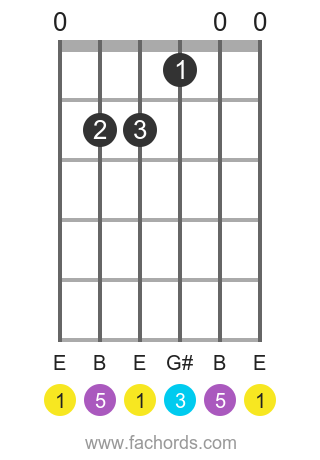
Made up of E, G#, B and in this case the E is already in the lowest bass note.
A very easy chord for first time guitar players.
Go to the E major chord animated video tabs.
F Major
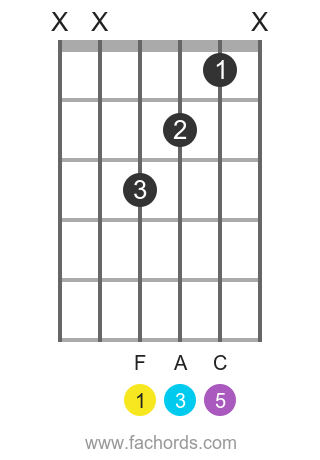
There is no open way to play an F major but we can cheat by playing XX321X, just mute the top two bass notes and the highest one.
In these three notes you play you still have the notes of an F major F, A, C.
Video tabs for the F major chord .
G Major
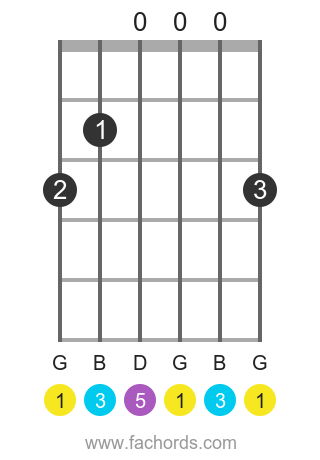
Another great guitar chord for a beginner, nothing too difficult on the fingers or any big stretches.
In G major we play the notes G, B, D.
G major chord video tabs.
A Major
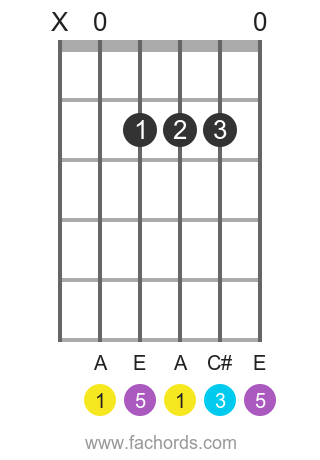
Here we have the notes A, C#, E for A major and this chord can be a little tricky due to the finger placement.
They can feel crammed in there at first.
And don't forget to mute the E string as that is not part of the A major chord!
Learn the A major chord all over the fretboard.
B Major
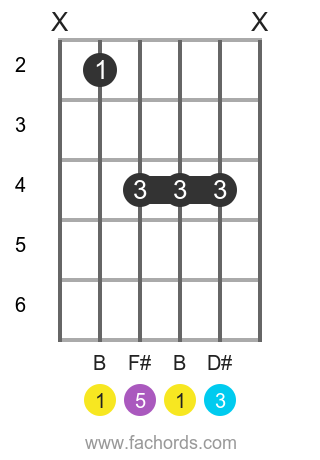
The chord B major is like the F major, they have no open variation, you have to mute strings to play a simplified version.
And like the F you will want to ease your way into the partial mute chords.
But for now if you need B, D#, F# or a B major chord this should do.
Find more shapes for the B major chord .
Minor Open Guitar Chords
C Minor
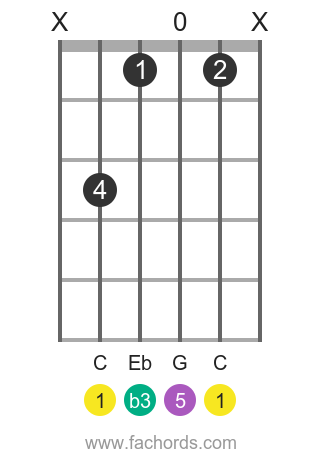
The minor chord is built using a similar tones formula , but this time we flatten that third note so it is 1, b3, 5.
Thus a C minor is C, Eb, G.
And it is the same for every single key just like the major.
And here it is as an open chord but with both sides muted.
Learn all the fingerings for the C minor chord .
D Minor
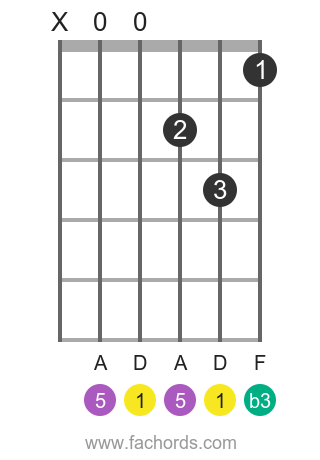
Here with the D, F, A we mute the top string like in the D major.
It is up to you which note you want to play in the bass.
D minor chord video tabs.
E Minor
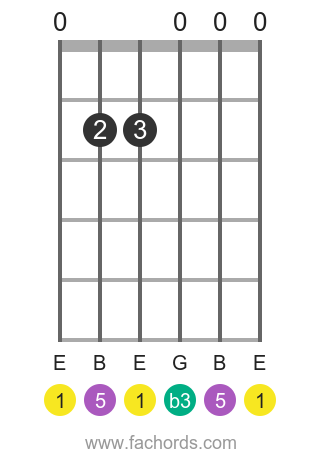
With just an E, G, B the E minor is one of the easiest guitar chords to play!
Find more ways to play the E minor chord .
F Minor

Like the F major we have no open version so we play a partial barre on the top four strings.
Ease your way into the full barre.
You will still have the notes F, Ab, C present in this partial chord.
Animated video tabs for the F minor chord .
G Minor
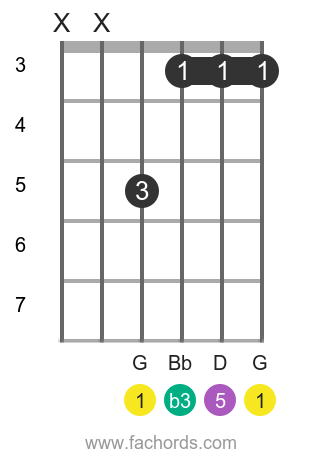
The G minor is also a barre chord but if you mute the top two strings you will still have the notes G, Bb, D.
Notice this is the same chord two frets up from the F minor.
Learn more ways to play a G minor chord .
A Minor
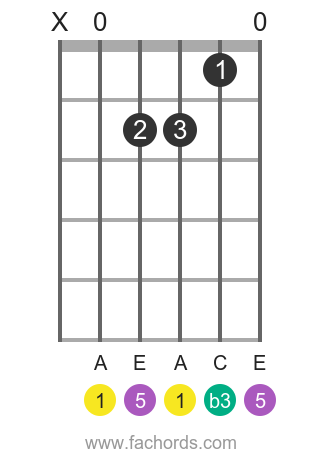
This is a much easier chord than the A major, with the notes A, C, E we have more space for our fingers.
Once again make sure you don't play the low E string.
Video with A minor chord fingerings.
B Minor
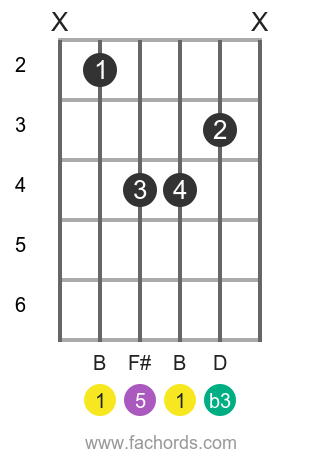
The Bm is a hard barre chord like the F and B, but if you mute the highest and lowest E strings you will still have the notes B, D, F#.
Animated video tabs for the B minor chord .
How to place fingers on the fretboard
You want to use the very tips of your fingers placed right before the metal fret .
You don't want to be directly on it or too far away.
While your fingers have no choice but to be bent we want to keep them up as straight as possible where they meet the string.
This way they won't accidentally mute other strings. Muted strings are one of the biggest problems for new players.
Play your chords slow at first and make sure all notes sound as they should or remain muted if necessary.
What about small hands or fat fingers?
For the most part these are generally not normal problems.
Yes depending on your size will affect what guitar you want; a tiny person might have an awkward time with a jumbo acoustic!
And the neck size is smaller on little guitars for those who need it.
But in general fat fingers and hand size issues are usually from lack of practice and training .
The more you fret your notes properly the better they will sound.
There are many famous big guys that play ukulele and mandolin, if they can play that, your fingers aren't too fat for a guitar!
Tips for practicing chord transition: how to switch from a shape to another
When playing instruments there are generally best practices on how to switch between chords :
our goal is to use the least movement in the fastest time.
That makes sense as we are playing the guitar fast during some songs.
However to truly use the best practices you need to advance into chords that are not open.
You will eventually need to use partial chords, muted strings, barre chords , or inversions to find the best way to switch.
Practice Simple Chord Progressions
But for now while you are playing these easier chords stick to chord progressions.
Common chord progressions are G-C-D and E-A-B , of course the first one in the key of G is easier than the key of E with that B chord!
Also use progressions like G-Em-C-D that is an easy one for most guitar beginners.
Practice transitioning chords that sound good together.
Other progressions are Dm-G-C , C-Em-F-G , and E-D-A these will get you started.
Later you will learn that these progressions are the foundations for most songs so they may sound familiar!
Exercises for gaining strength and flexibility
One of the best exercises is to hold the chord down while you play all the notes individually.
This is called playing an arpeggio and you can make sure each note sounds as it should.
This is especially important when muting strings.
As you hold the chord down and focus on playing every note your strength will grow with each practice.
Play the chord progressions above slow at first and build your speed . Look up songs you like during each practice and play them.
The more songs you play the better you get at transitions and strength.
Just don't overdo your playing as the strings can make the fingers really sore .
But with each practice break through a little of that pain and you will get there.
Make sure to practice the chords above like B and F and slowly work on adding the top two bass notes.
Thumb Position: Some Tips
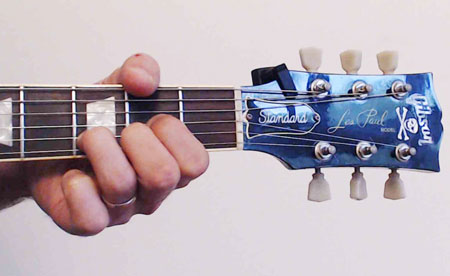
Thumb position is a little quirky.
The traditional method is to have the tip of your thumb near the center of the back of the neck, giving you the most flexibility in your other fingers.
This is great for classical, flamenco, and finger-style players, but it can be a little tiresome for someone who mostly strums chords.
For chords, you may want to use the ball of your thumb a little above the center, which allows you to use more of the muscles in your wrist
Yes, your wrist muscles is what powers your grip strength, not the muscles in your fingers.
Those muscles are just for curling fingers, and give you a bit more leverage, especially useful for bar chords.
Many modern players use the first joint of the thumb against the back of the neck, and almost on the upper binding, sort of like gripping a baseball bat so that they can reach over the neck with their thumb tip to play bass notes on the E and A strings while picking melodies out with the other fingers.
Tommy Emmanuel, and Andy McKee are particularly adept at this.
You'll need to experiment with some to find what works best for you.
Your wrist should just curl naturally as you play.
Too much, or too little will cause forearm soreness.
It should feel good and natural, not strained.
Your upper arm should just hang naturally, not cocked out laterally, nor forced inward towards your ribs
Open Guitar Chords - Conclusions
While open chords are great to start on you want to keep building your strength up until you can play those full barre chords.
When you know these it's easier to move up the fretboard and find your chords at various spots.
You will also want to start getting better at string muting as this is important when playing chords up the neck.
Keep practicing your open chords and soon you will be able to move on to the rest of the guitar fretboard.
Don't forget to download the free guitar chords ebook , that will teach you many other ways to play major and minor chords all along the fretboard.